Jump to: Historical Context | Factors Affecting the Value | Varieties | FAQs
The Lincoln Cent is the one-cent American coin that the United States Mint has been striking since 1909. Though the reverse design has gone through many changes over the years, President Abraham Lincoln’s effigy on the obverse, designed by Victor David Brenner, still stands.
The Lincoln Penny is one of the most collected US coins. In fact, prices for a 1942 Lincoln Penny, in particular, can vary between $1,000 and $9,500 in Superb Gem condition!
The Lincoln effigy was a tribute to Lincoln's centennial's birth and the first widely circulating coin with a president's design on it. At first sight, it is the type of coin that can be found in pocket change, but the coins you will see in this article are true prizes!
Key Takeaways
- The 1942 Lincoln Wheat Penny was the last copper penny before copper was removed from coinage production to be used in World War II efforts;
- Factors like condition and rarity play a significant part in the 1942 Lincoln Penny value. In Superb Gem condition, a specimen from Philadelphia can fetch prices over $1,000. If from San Francisco, up to $9,500;
- The 1942 Lincoln Wheat Penny from the San Francisco Facility has the lowest mintage number from that year, so it is the most sought-after variety of the 1942 issue;
Historical Context
To fully grasp the significance of this iconic coin, let's explore how historical events, such as World War II, shaped its value and composition.
World War II And Its Impact On The Penny's Value
When the U.S. entered World War II in 1941, copper was highly demanded for the production of assault wires, ammunition, and other military equipment.
The problem was that the cent was actually made of copper. So, in 1943, the US Mint had to change the composition of the cent to one made of zinc-coated steel.
The 1942 Lincoln wheat penny was the last copper penny made during that period. Copper would only return in the 1944 Penny.
This pre-war context adds to the coin's historical significance and very well represents the meaning of numismatic value. It does not rely solely on the composition itself but on what each detail represents at a given moment in history.
Interestingly, when the need for copper had passed, the Treasury quietly removed as many 1943 steel pennies as possible, in fear that once people knew the movement, they would hoard the coins.
This sudden change in composition also created one of the rarest mint errors in US Mint history: the 1943 Copper Penny.
Factors Affecting 1942 Penny Value
Design
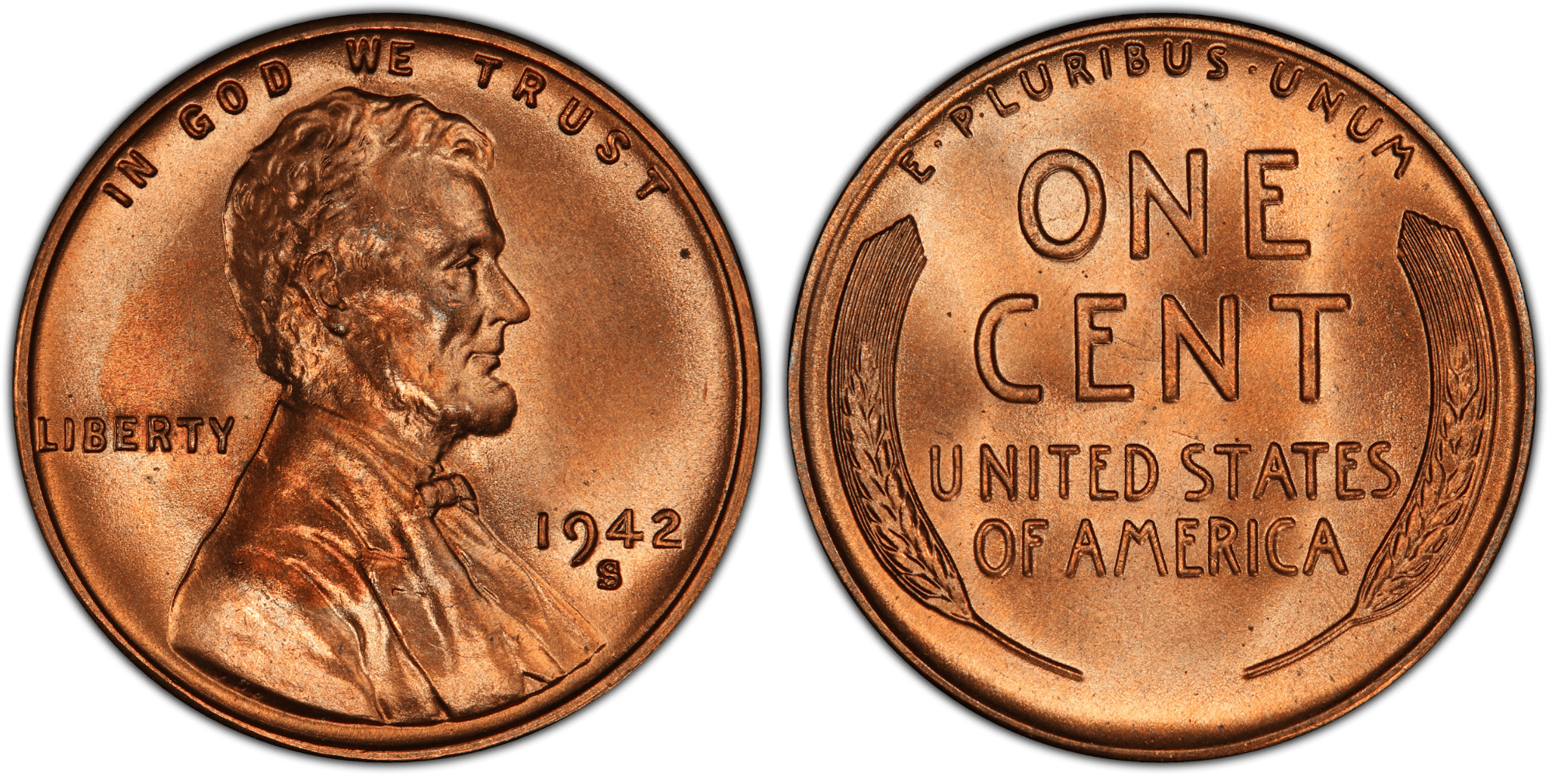
The obverse of the coin, designed by Victor David Brenner, features former president Abraham Lincoln. On top of his head is placed the traditional American motto: IN GOD WE TRUST. On the left, lies the word LIBERTY, and on the lower right, the year and mint mark, which indicates where the coin was produced. In this case, the coin represented above was produced at the San Francisco Mint. Those struck at the Denver Mint carry the “D” mint mark, while coins from the Philadelphia Mint have no mint marks.
The coin's reverse depicts two stalks of wheat, which is why it is also known as the wheat penny. At the center is the denomination ONE CENT, and below it is the country’s name, UNITED STATES OF AMERICA. On top of the design is written E PLURIBUS UNUM, which means "out of many, one."
Read more about the most valuable Wheat Pennies in our article.
Penny's Condition
The condition of a coin is usually accessed by a grade. Third-party grading services like PCGS and NCG will authenticate your coin, as well as place it in a specific place within the Sheldon Scale.

The Sheldon scale is the most used grading scale in the numismatic world and plays a significant role in determining prices.
As you might imagine, the better conserved a coin is, the more original design details and original luster it will have, so more collectors might be willing to pay larger sums for it.
The coins are graded from 1 (very poor condition) to 70 (perfect condition), and coins between 60 and 70 are represented by the letters MS or Mint State.
You will notice that a proof coin also has a similar grading system, but they actually carry the PR for Proof instead of MS (of Mint State).
Colors
Copper coins are also classified as Red, Red-Brown, and Brown based on how the copper metal reacts to environmental exposure. This happens because copper starts to oxidize upon contact with air.
These classifications, established by numismatics, indicate different levels of oxidation and affect the coins' value.
Read further to understand each color's meaning and impact on Lincoln Cents' pricing.
RED (RD)
A copper penny, primarily composed of copper with 5% zinc, exhibits a red hue when newly minted due to copper's natural color. The Professional Coin Grading Service (PCGS) classifies such coins as "Red" if they retain 95% or more of their original mint red hue, indicating both the composition and the coin's condition.
RED-BROWN (RB)
PCGS professionals determine copper coins as Red and Brown when they grade MS60 or higher and retain 5% to 95% of their original mint red color. These coins still show some red hue, but oxidation has begun, creating a more circulated condition and generally reducing their value for collectors.
BROWN (BN)
PCGS designates copper coins as Brown if they display less than 5% of their original mint red color. Compared to other coins, brown coins tend to be worn. While various factors influence the desirability of copper coins, many collectors prefer Red ones due to their typically better condition and higher value. Consequently, Brown coins generally have a lower value.
Understanding the distinct colors of copper coins can also serve as a safeguard against counterfeit coins, as each condition typically presents a specific tone that collectors can demand when selling and anticipate when purchasing.
Mintage Numbers
In 1942, the Philadelphia Facility produced the most Lincoln pennies, totaling 657,796,000 coins. The Denver Mint followed with a significantly lower mintage of 206,698,000 pennies. The San Francisco's had the smallest production, minting just 85,590,000 Lincoln pennies.
Over time, the lower San Francisco mintage has made these coins rarer, contributing to their numismatic value. This scarcity is why San Francisco mintages are often the most expensive.
Varieties
Now that you know that grade and mintage numbers are crucial when evaluating these coins, see below the most valuable coins from the varieties in the 1942 Lincoln wheat penny series.
1942 Lincoln Penny Red (Regular Strike)
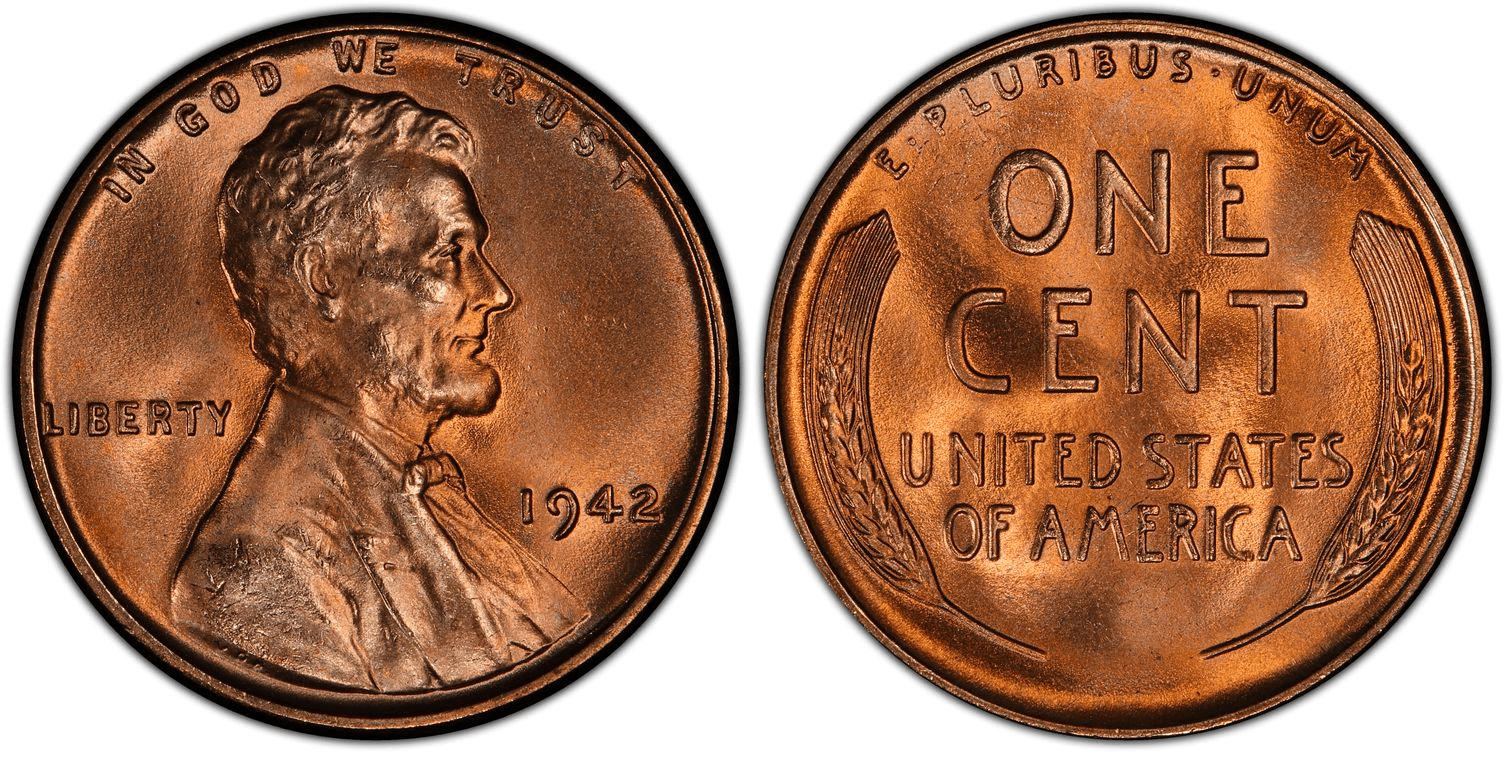
The Lincoln Penny shown above is in Superb Gem condition (MS67+). Notice that the Philadelphia issue, unlike the others, does not bear any mint marks.
An MS68 specimen, sold at an auction in 2021 for $3,960, holds the price record for this variant.
1942-D Lincoln Penny Red (Regular Strike)
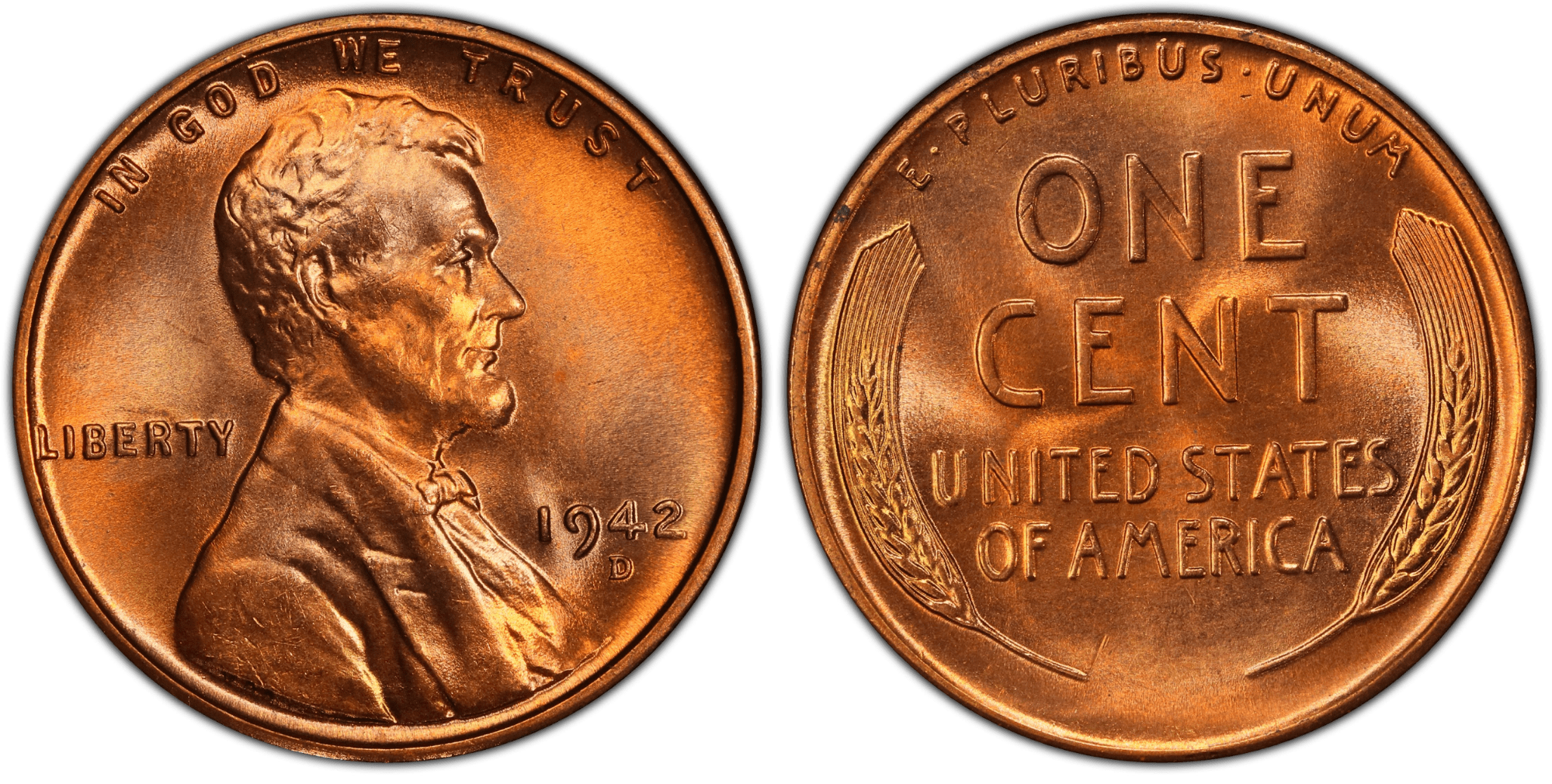
The 1942-D Lincoln Cent is relatively common. While MS66 examples are somewhat harder to find, thousands likely remain in uncirculated rolls.
This issue was well-struck. Though MS68 examples are very scarce, the image above shows a Red 1942 Wheat Penny graded as Mint State 68 sold in 2008 for $12,650 at Heritage Auctions.
1942-S Lincoln Penny Red (Regular Strike)
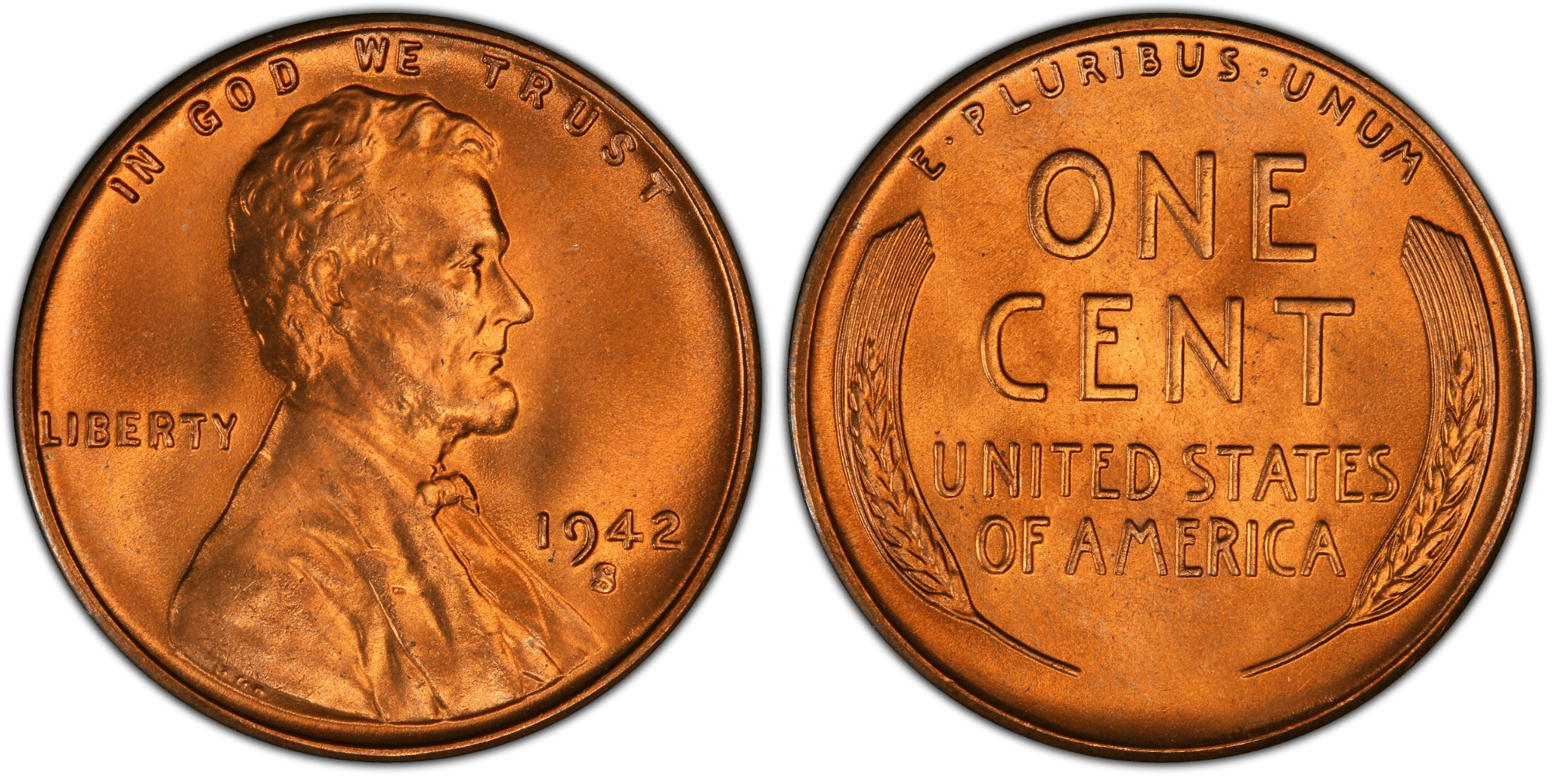
This 1942-S Penny value can fetch around $9,500 in red color in high grades. In brown or red-brown colors, it stays between $5 and $50$, even in uncirculated condition.
The record for this variety was $12,650 when an MS68 was sold in 2006 at Heritage Auctions.
1942-S/S Lincoln Penny RPM FS-512, Red (Mint Error)
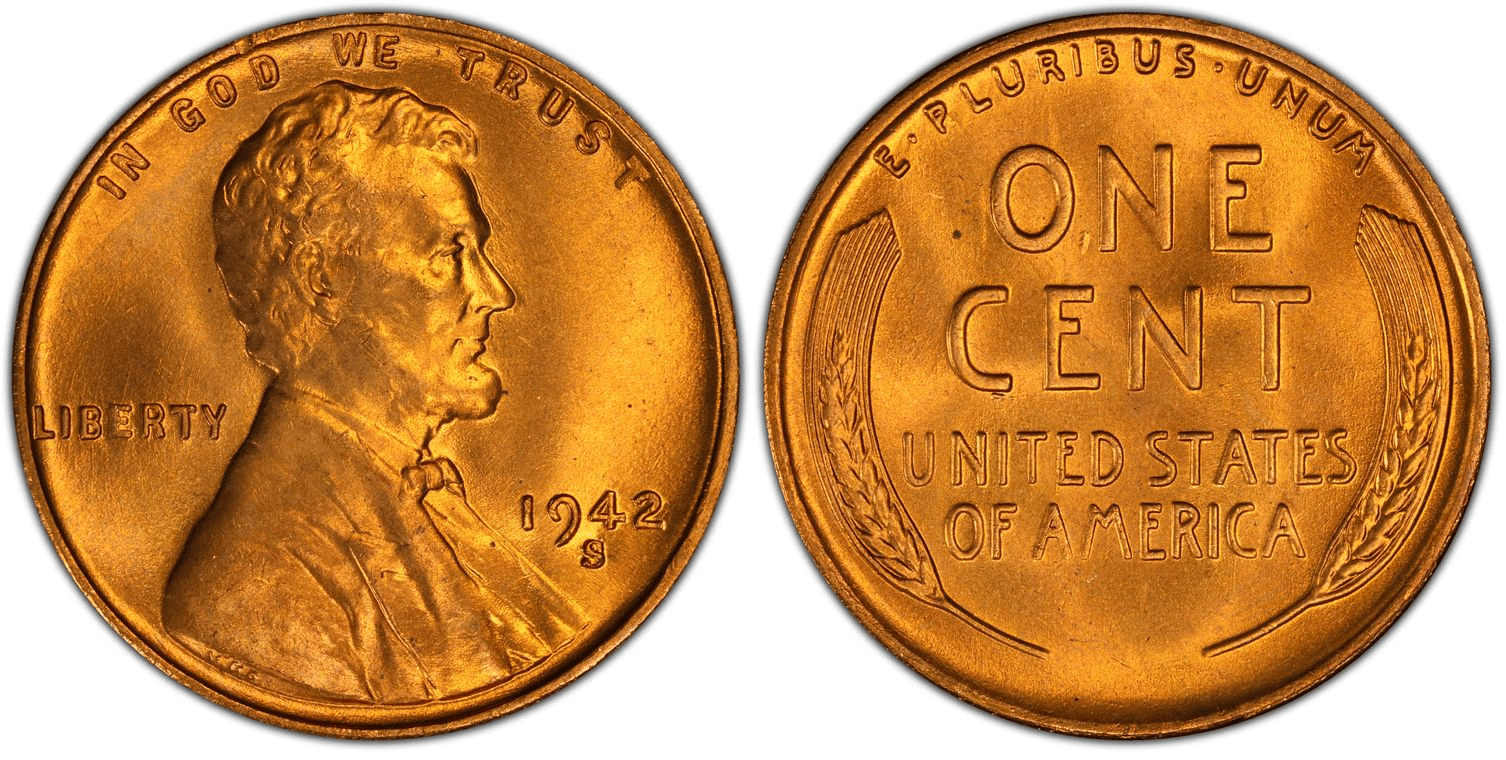
With a very low surviving population registered by PCGS, the red 1942-S/S 1C RPM FS-512 variety is characterized by its doubled mintmark.
PCGS has graded only 2 specimens of this error coin in Superb Gem Uncirculated condition (MS67), each valued at approximately $1,800, according to its price chart.
The record price was $1,763 for a Red MS67 in 2020 at Legend Rare Coin Auctions.
Check out our complete list of penny errors to look for.
1942-S/S/S 1C DDO & RPM FS-101/301, Red (Mint Error)
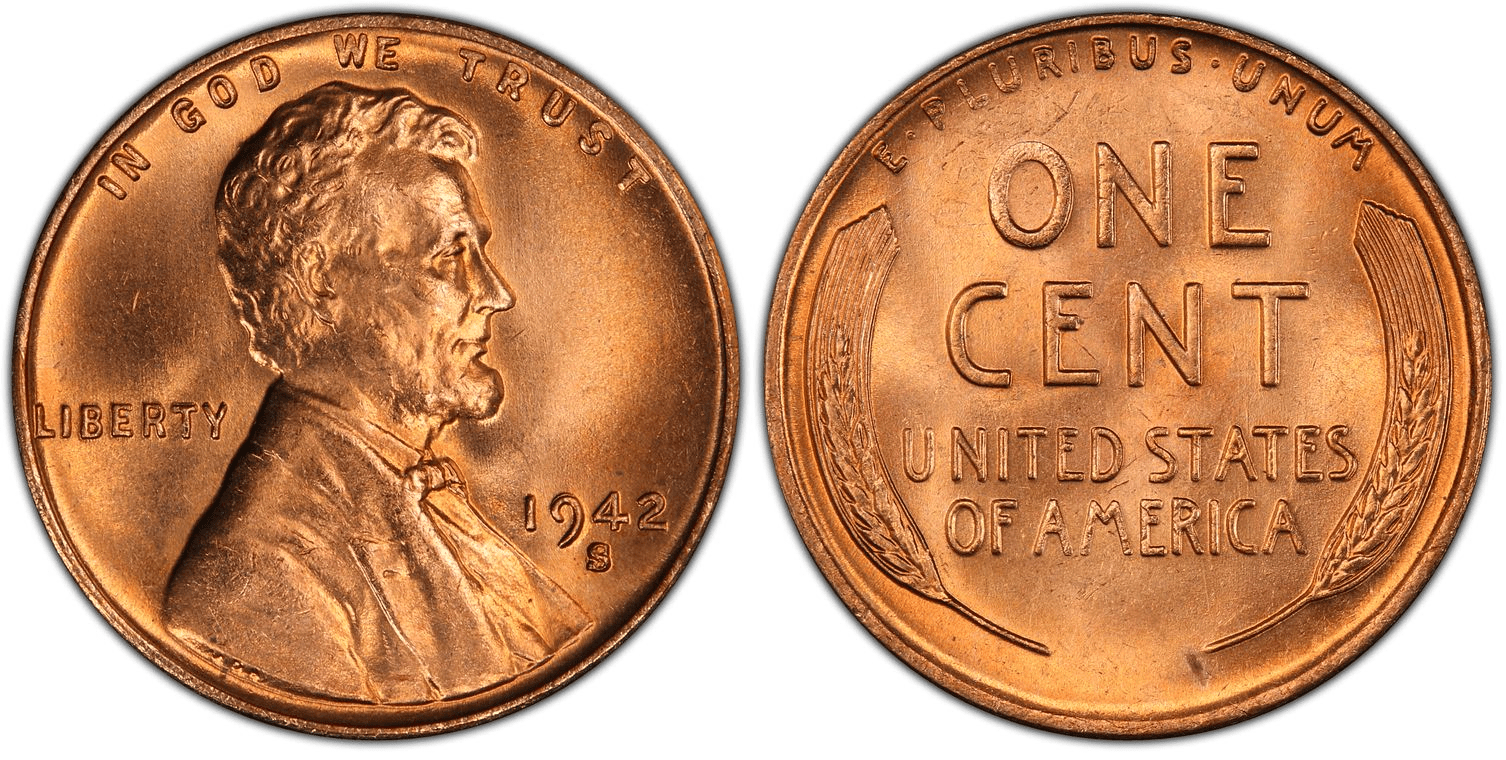
The highest grade for this one is MS67, and only three examples have been registered by PCGS. The main aspect of this coin is its repunched mintmark and a slightly noticedable double die obverse.
The record price for a Red MS67 on eBay in 2019 was $2,350.
1942 1C J-2079 Lincoln Aluminum (Special Strike)
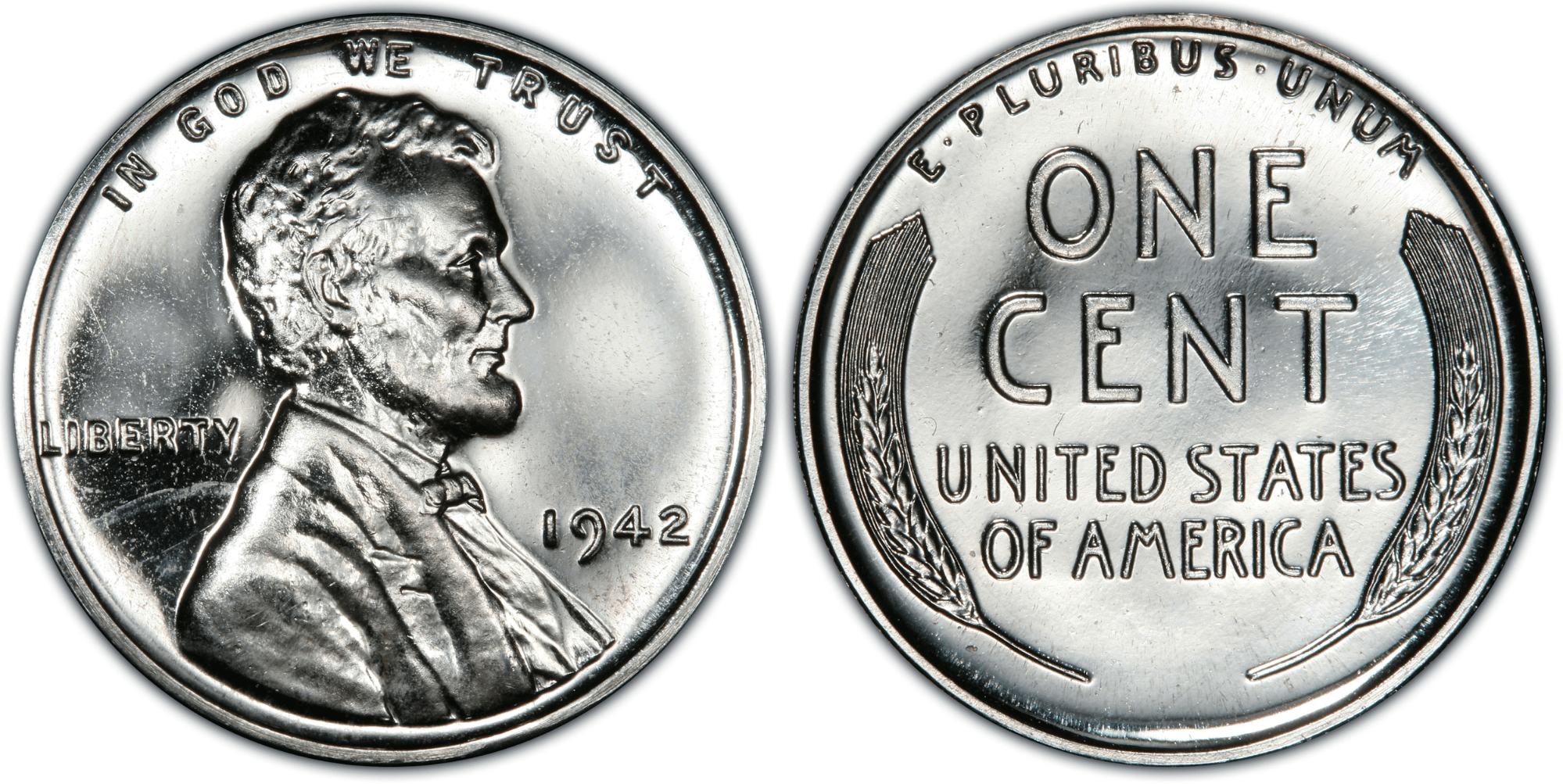
PCGS has only one coin of this variety registered. This special strike was made to test a new proposed composition for 1943 with an aluminum alloy and did not go into circulation. Because they are very rare, their prices tend to fetch a lot higher than those of their regular strike counterparts, even in average conditions.
An auction record was set on April 23, 2014, at Heritage Auctions, where this coin, graded as Proof 66, sold for $199,750!
1942 1C, CAMEO (Proof)
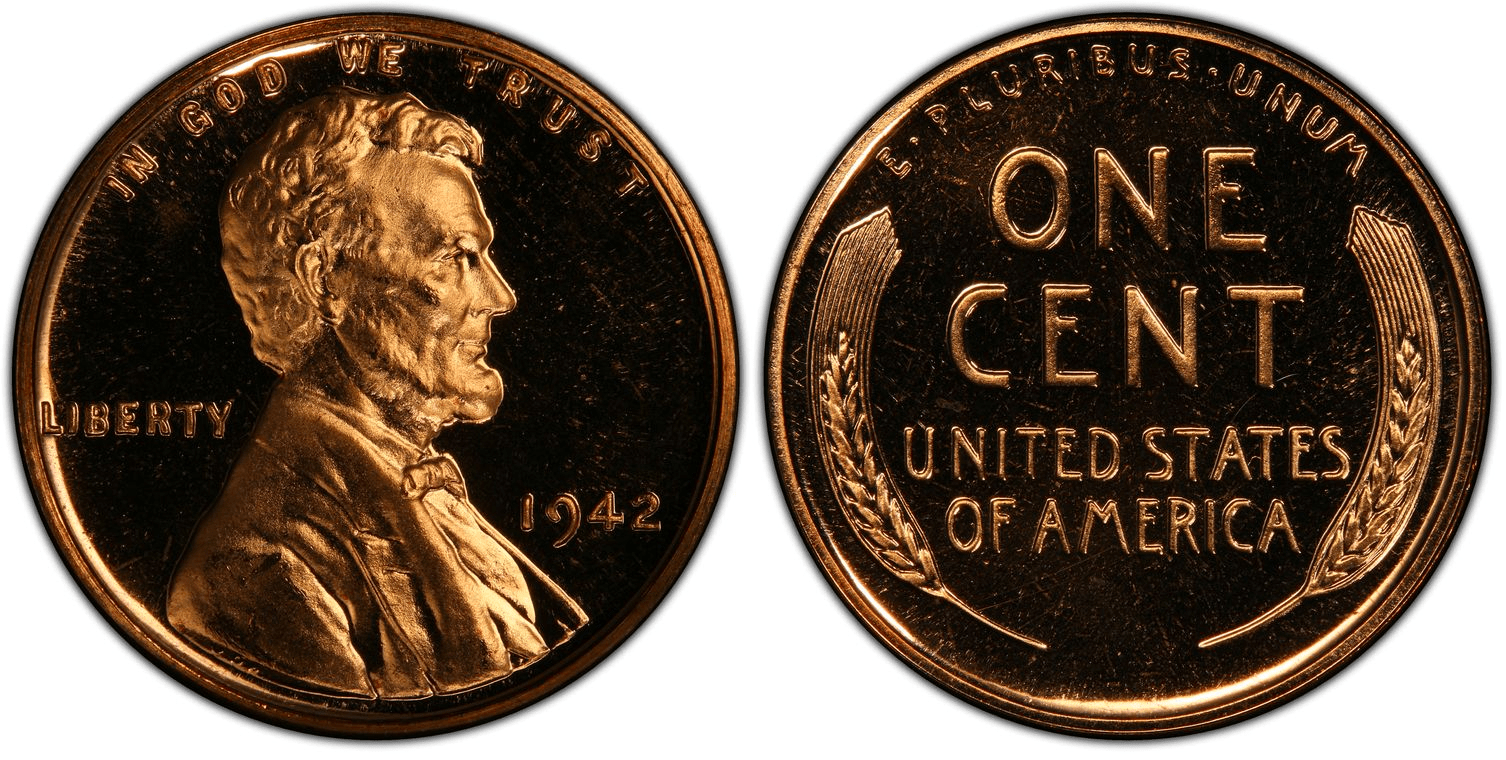
Proof coins are typically minted for collectible purposes. They are made using highly polished planchets and specially prepared dies, which must be in near-perfect condition. Historically, acid-treated dies created frosted devices for a cameo-mirror contrast. Today, digital technology and computer-aided lasers produce precise frosted texturing on any part of the die.
Cameo coins tend to fetch higher because of The high contrast that emphasizes the design and coin features.
An auction record was set on February 3, 2014, at Heritage Auctions, where a coin graded PR67 sold for $17,625.
Read more about Who Is On The Penny in our article.
Final Thoughts
In this article, we discussed how the value of the 1942 Lincoln penny is primarily influenced by mintage numbers, which enhance its collectible appeal. Due to its copper composition, the condition of the penny is often indicated by its color. Even a less experienced eye can easily spot the color variation, which significantly contributes to the coin's visual appeal.
The 1942 Lincoln pennies were the last to contain copper before changes made during World War II, adding to their historical significance and coin values.
These factors make the 1942 One Cent coins highly regarded among collectors and an important piece of history.
FAQs
What makes a 1942 penny so valuable?
For 1942 specifically, most of the high prices come from rare coins. Wheat Pennies from San Francisco are hard to find in pristine, uncirculated condition.
How much is a 1942 S penny worth?
The 1942 Lincoln pennies minted at the San Francisco facility are the less mintage of the year. In 1942, the Philadelphia Mint and Denver's produced, respectively, 657,796,000 and 206,698,000 pennies. The San Francisco's, however, had the smallest production, minting just 85,590,000 Lincoln pennies.
How do I know if my 1942 penny is valuable?
The most valuable coins are the ones in good condition. Usually, you can tell if the coin is in good condition if it still retains most of its copper-reddish color. But the best way of finding out if your 1942 Lincoln Penny is valuable is to have it graded by a third-party grading service like PCGS or NGC.
How many 1942 copper pennies were made?
In 1942, the Philadelphia Mint produced the most Lincoln pennies, 657,796,000 coins in total. The Denver Facility followed with a significantly lower mintage of 206,698,000 pennies. The San Francisco's had the smallest production, minting just 85,590,000 Lincoln pennies.
What penny is worth $50,000?
This 1959-D Lincoln Cent "mule" combines the 1959-D obverse with the 1958 Wheat reverse. While the 1959-D Lincoln Cent was anticipated to showcase the Lincoln Memorial reverse, instances of it with the Wheat reverse have emerged. It fetched up to $50,000 in recent auctions.
Discovered by a retired police officer, this unusual error was authenticated by the Forensic Services Division in Washington, D.C., affirming its authenticity.
















